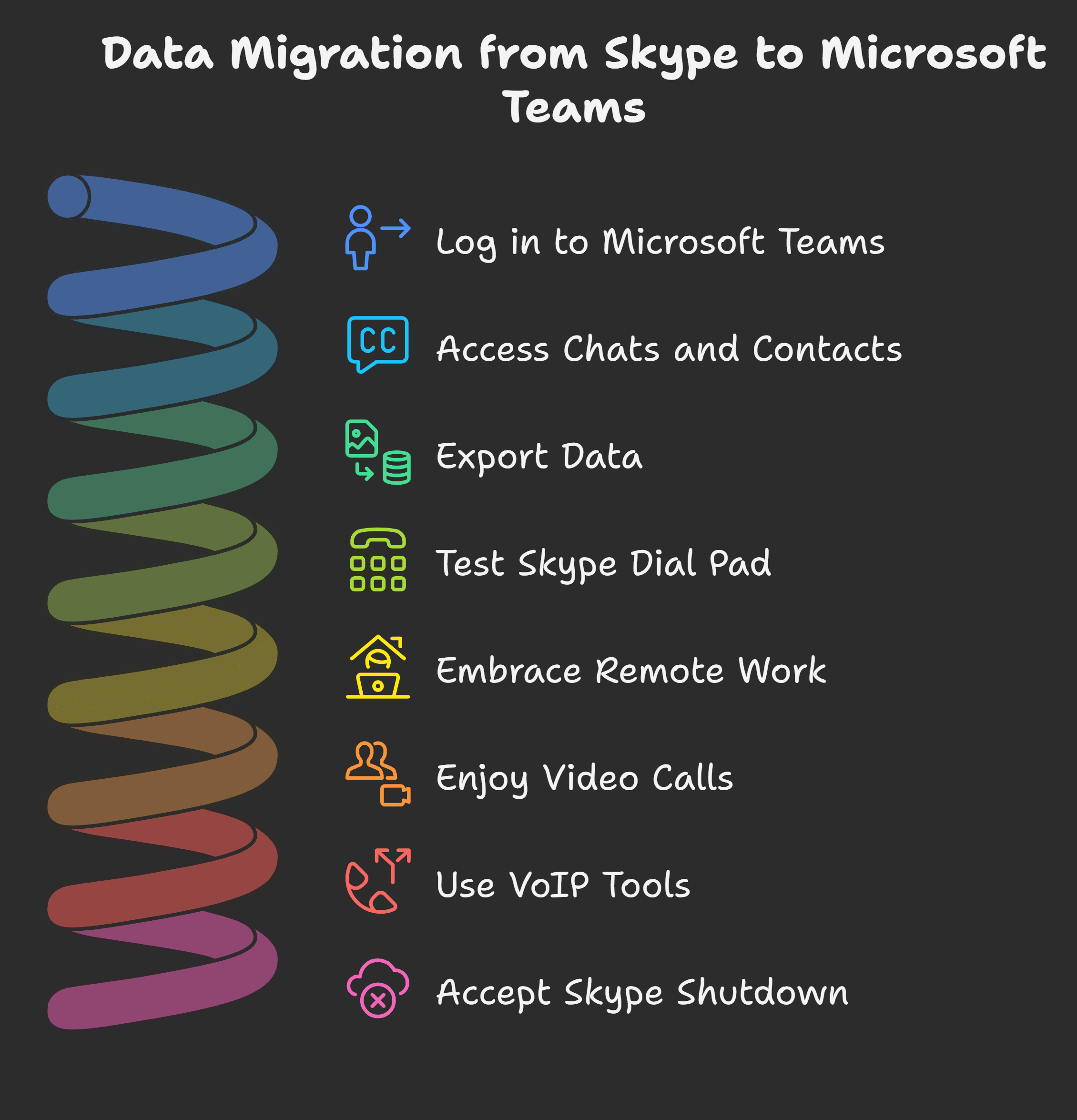Many users now worry about losing their favorite video call and text chatting tool. Why Is Skype Shutting Down is a real issue, as Microsoft will close the service in May 2025. This post explains how Microsoft shifted from Skype for Business to Microsoft Teams, shows why Skype lost ground to emerging apps, and tells you how to move your data safely.
Read on.
Key Takeaways
- Microsoft will shut down Skype in May 2025 after more than 20 years of service.
- Microsoft shifts its focus to Microsoft Teams, which now has 320 million monthly active users.
- Users can transfer their chats, contacts, and call records easily from Skype to Teams using their current credentials.
- Competition from platforms like Zoom and Slack, along with issues on cellphones, caused Skype to lose ground over time.
The End of Skype by Microsoft
Microsoft ends Skype after more than 20 years of service. The tech giant now focuses on Microsoft Teams for video calls and remote work.
Shifting Focus to Microsoft Teams
Launched in 2017, Microsoft Teams now serves over 320 million monthly active users. Skype users switch with ease using their current Skype credentials. Chats and contacts migrate automatically to Teams.
Video calls, remote work, and the covid-19 pandemic have pushed adoption forward. Jeff Teper backs the move as users enjoy free access, an improved privacy policy, and seamless syncing with the Skype dial pad.
Users experience a smooth change from Skype to Microsoft Teams without major hassle. Contacts and chats transition automatically, and Teams supports video calls along with remote work.
The simple shift boosts efficient communication for personal and business use. Keep reading to explore factors behind Skype’s declining popularity.
Factors Behind Skype’s Declining Popularity
Modern video call platforms and chat tools boost remote work, and better voice over IP services attract users to Microsoft Teams while Skype grows weaker—read on to learn more.
Challenge from Emerging Communication Platforms
Emerging platforms challenge Skype hard. Competitors like Zoom and Slack offer easier video calls and collaborative apps. Skype lost many users from a peak of hundreds of millions.
The app faced pricing issues and did not adapt well to cellphones. Skype dial pad flaws grew clear as demands shifted.
Microsoft Teams launched in 2017 and thrived during the covid-19 pandemic. Jeff Teper led efforts that shifted focus to Microsoft 365 and remote work. New voice-over-internet protocol services and trusted instant messenger tools outpaced older methods.
Companies and users now choose more user-friendly options for their communication needs.
Guidance for Skype Users on Data Transition
Skype users can move their chat logs, contacts, and call records to Microsoft Teams with clear steps. A simple guide shows how to shift data smoothly so you can continue using video calls and remote work tools.
How to Transfer Data to Microsoft Teams
Data migration is easy. Follow these steps to move your data.
- Log in with your Skype credentials on Microsoft Teams.
- Access your chats and contact list with the same information.
- Export data if you choose not to migrate immediately.
- Test the new Skype dial pad feature to ensure proper functionality.
- Embrace remote work with improved collaborative apps and video calls.
- Enjoy crisp video calls that meet needs seen during the COVID-19 pandemic.
- Use voice-over IP tools on your Windows phone and smartphones for clear calls.
- Accept the Skype shutdown as Microsoft retires Skype in May 2025.
- Follow Jeff Teper’s guidance to ensure a smooth data transition.
- Benefit from a system that supports mobile data and traditional telephone calls.
Microsoft’s Future in Communication Technologies
Microsoft takes clear steps to shape next-gen communication tools with Microsoft Teams and Skype for Business. Their upgrades boost remote work, video calls, and messaging apps while adding strong data security through cloud-based voice-over IP features.
Consolidating Services to Enhance Competitiveness
Skype will shut down in May 2025. The company moves users to Microsoft Teams, which now serves 320 million monthly active users. People sign in with their Skype credentials.
The platform boosts remote work and video calls while easing the switch from features like the Skype dial pad.
Service consolidation cuts costs and clears confusion for users. The firm acquired Skype in 2011 for $8.5 billion to grow its suite of communication tools. Jeff Teper leads efforts that merge Skype for Business with Microsoft Teams.
Users may keep Skype credits as they migrate to the new platform. The covid-19 pandemic drove demand for collaborative apps and strong privacy policy measures.
Takeaways
Microsoft ends a service that shaped our communication for over two decades. The company now relies on Microsoft Teams to power modern voice over IP and video calls. Engineers built the platform to support remote work and collaborative apps.
Users must transfer their data by May 2025 to keep their contacts and history intact.
FAQs
1. Why is Skype shutting down after over two decades?
Skype is ending its service as users turn to modern solutions like Microsoft Teams and Skype for Business. Leaders such as Jeff Teper and the Skype tech firm see a shift toward remote work and video calls, with changes driven by the Microsoft acquisition. Tools like the Skype dial pad and voice over IP have been important, while privacy policy updates and validations like Google reCAPTCHA ensure security.
2. What role did global events like the COVID-19 pandemic play?
The COVID-19 pandemic accelerated the move to remote work and video calls, leading many to choose collaborative apps over older platforms. News from TechCrunch.com, major cable news outlets, and discussions on the Internet stressed this shift. Even traditional services like AOL chat service have seen their place shrink as new tools take over.
3. How does competition from apps like Microsoft Teams influence the decision?
Microsoft Teams offers robust features that attract users away from Skype. Jeff Teper and other tech leaders note that tools such as the Skype dial pad and voice over IP, coupled with integrated features in collaborative apps and Skype for Business, have reshaped how we make video calls and manage remote work. Threads on platforms like Facebook and Bing search engine articles further emphasize this change.
4. What impact does the Microsoft acquisition have on Skype’s future?
The Microsoft acquisition paved the way for better integration with modern work tools, seen in apps like Microsoft Teams and Skype for Business. This change has influenced industry benchmarks, from the S&P 500 to Dow Jones reports, and even affected traditional networks like the public switched telephone network. Updated privacy policies and secure features like Google reCAPTCHA help ease the transition.
5. How are legacy elements like Skype credits and the firm’s history affected?
Skype credits and the long history of the Skype tech firm remain part of its legacy. While the shutdown marks the end of an era, the influence of services like voice over IP, video calls, and even innovations echoing from the days of AOL chat service persist. Reports from sources like TechCrunch.com, debates on threads across Facebook, and updates on Bing search engine reflect the ongoing transformation of collaborative apps and the familiar features of the traditional phone network.
References
- https://www.nytimes.com/2025/02/28/technology/microsoft-skype-shutting-down.html
- https://www.geekwire.com/2025/end-of-an-era-microsoft-to-shut-down-skype-shifting-users-to-teams-14-years-after-8-5b-deal/
- https://www.theguardian.com/technology/2025/feb/28/microsoft-skype
- https://www.timesnownews.com/technology-science/microsoft-retires-skype-after-two-decades-moves-users-to-teams-how-to-migrate-your-chats-article-118641319









































